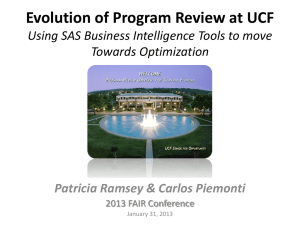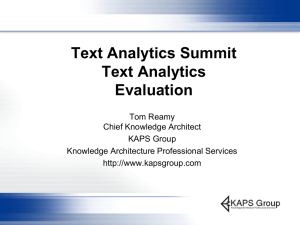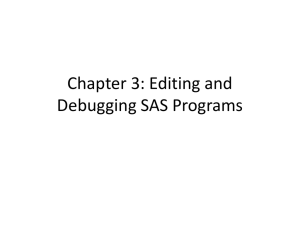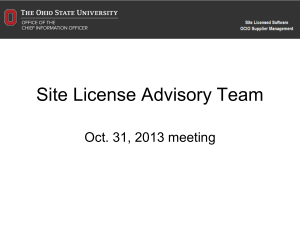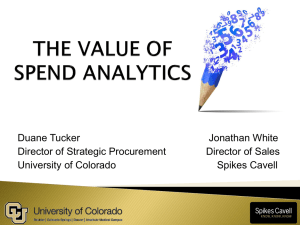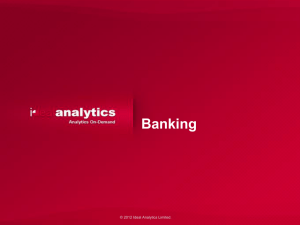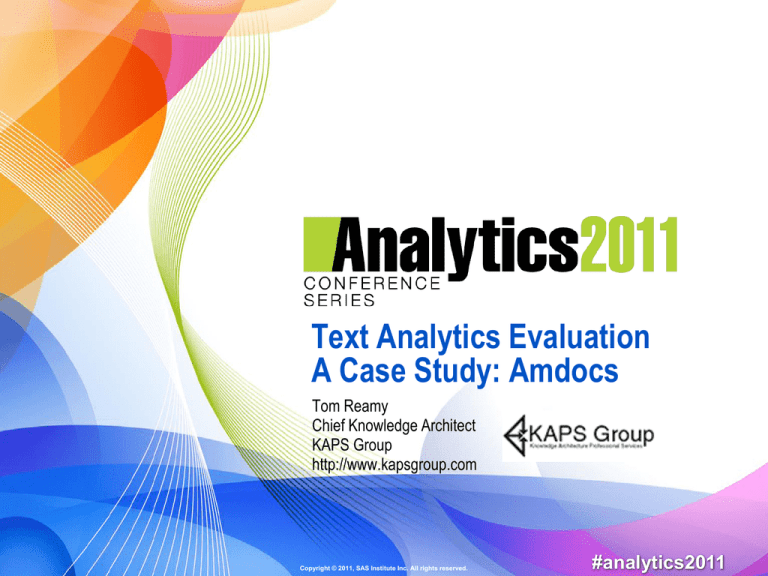
Text Analytics Evaluation
A Case Study: Amdocs
Tom Reamy
Chief Knowledge Architect
KAPS Group
http://www.kapsgroup.com
Copyright © 2011, SAS Institute Inc. All rights reserved.
#analytics2011
Text Analytics Evaluation Case Study
Agenda
Introduction – Text Analytics Basics
Evaluation Process & Methodology
Two Stages – Initial Filters & POC
Initial Evaluation Results
Proof of Concept
Methodology
Results
Final Recommendation
Sentiment Analysis and Beyond
Conclusions
Copyright © 2011, SAS Institute Inc. All rights reserved.
#analytics2011
KAPS Group: General
Knowledge Architecture Professional Services
Virtual Company: Network of consultants – 8-10
Partners – SAS – 2 Whitepapers (Semantic infrastructure)
GAO, FDA, Amdocs – Sales & Development Projects
Other Partners: Smart Logic, FAST, Concept Searching, etc.
Consulting, Strategy, Knowledge architecture audit
Services:
Text Analytics evaluation, development, consulting, customization
Knowledge Representation – taxonomy, ontology, Prototype
Knowledge Management: Collaboration, Expertise, e-learning
Applied Theory – Faceted taxonomies, complexity theory, natural
categories
3
Copyright © 2011, SAS Institute Inc. All rights reserved.
#analytics2011
Text Analytics Evaluation Case Study
Text Analytics Features
Noun Phrase Extraction
Catalogs with variants, rule based dynamic
Multiple types, custom classes – entities, concepts, events
Feeds facets
Summarization
Customizable rules, map to different content
Fact Extraction
Relationships of entities – people-organizations-activities
Ontologies – triples, RDF, etc.
Sentiment Analysis
Rules – Objects and phrases
Copyright © 2011, SAS Institute Inc. All rights reserved.
#analytics2011
Introduction to Text Analytics
Text Analytics Features
Auto-categorization
Training sets – Bayesian, Vector space
Terms – literal strings, stemming, dictionary of related terms
Rules – simple – position in text (Title, body, url)
Semantic Network – Predefined relationships, sets of rules
Boolean– Full search syntax – AND, OR, NOT
Advanced – DIST (#), PARAGRAPH, SENTENCE
This is the most difficult to develop
Build on a Taxonomy
Combine with Extraction
If any of list of entities and other words
5
Copyright © 2011, SAS Institute Inc. All rights reserved.
#analytics2011
6
Copyright © 2011, SAS Institute Inc. All rights reserved.
#analytics2011
7
Copyright © 2011, SAS Institute Inc. All rights reserved.
#analytics2011
8
Copyright © 2011, SAS Institute Inc. All rights reserved.
#analytics2011
9
Copyright © 2011, SAS Institute Inc. All rights reserved.
#analytics2011
10
Copyright © 2011, SAS Institute Inc. All rights reserved.
#analytics2011
11
Copyright © 2011, SAS Institute Inc. All rights reserved.
#analytics2011
Evaluating Text Analytics Software
Start with Self Knowledge
Strategic and Business Context
Strategic Questions – why, what value from the taxonomy/text
analytics, how are you going to use it
Info Problems – what, how severe
Formal Process - KA audit – content, users, technology, business
and information behaviors, applications - Or informal for smaller
organization, application specific initiatives
Text Analytics Strategy/Model – forms, technology, people
Existing taxonomic resources, software
Need this foundation to evaluate and to develop
12
Copyright © 2011, SAS Institute Inc. All rights reserved.
#analytics2011
Evaluating Text Analytics Software
Start with Self Knowledge
Do you need it – and what blend if so?
Taxonomy Management Full Functionality
Multiple taxonomies, languages, authors-editors
Technology Environment – Text Mining, ECM, Enterprise Search
Where is it embedded, integration issues
Publishing Process – where and how is metadata being added –
now and projected future
Can it utilize auto-categorization, entity extraction, summarization
Applications – text mining, BI, CI, Social Media, Mobile?
13
Copyright © 2011, SAS Institute Inc. All rights reserved.
#analytics2011
Evaluation Process & Methodology
Team - Interdisciplinary
IT – Large software purchase, needs assessment
» Text Analytics is different – semantics
» Construction company designing your house
Business – Understand the business needs
» Don’t understand information
» Restaurant owner doing the cooking
Library - know information, search
» Don’t understand the business, non-information experts
» Accountant doing financial strategy
Team – 3 KAPS - Information
5-8 Amdocs – SME - business, Technical.
14
Copyright © 2011, SAS Institute Inc. All rights reserved.
#analytics2011
Evaluation Process & Methodology
Amdocs Requirements / Initial Filters
Platform – range of capabilities
Categorization, Sentiment analysis, etc.
Technical
API’s, Java based, Linux run time
Scalability – millions of documents a day
Import-Export – XML, RDF
Total Cost of Ownership
Vendor Relationship - OEM
Usability, Multiple Language Support
15
Copyright © 2011, SAS Institute Inc. All rights reserved.
#analytics2011
Evaluation Process & Methodology
Two Phases
Phase I – Traditional Software Evaluation
Filter One- Ask Experts - reputation, research – Gartner, etc.
» Market strength of vendor, platforms, etc.
Filter Two - Feature scorecard – minimum, must have, filter to
top 3
Filter Three – Technology Filter – match to your overall scope
and capabilities – Filter not a focus
Filter Four – In-Depth Demo – 3-6 vendors
Phase II - Deep POC (2) – advanced, integration,
semantics
16
Copyright © 2011, SAS Institute Inc. All rights reserved.
#analytics2011
Phase I – Case Study
Attensity
Lexalytics
SAP – Inxight
Multi-Tes
Clarabridge
Nstein
ClearForest
SAS
Concept Searching
SchemaLogic
Data Harmony / Access
Innovations
Smart Logic
Expert Systems
Enterprise Search
GATE (Open Source)
IBM
Content Management
Sentiment Analysis Specialty
Ontology Platforms
17
Copyright © 2011, SAS Institute Inc. All rights reserved.
#analytics2011
Phase I - 4 Demos
SmartLogic
Taxonomy Management, good interface
20 types of entities, API’s, XML-Http
Full Platform – no Sentiment Analysis
Expert Systems
Different Approach – Semantic Network – 400,000 words / 3,500
rules, 65 types of relationships
Strong out of the box – 80%, no training sets
Language concerns – no Spanish, high cost to develop new ones
Customization – add terms and relationships, develop rules –
uncertain how much effort, use their professional linguists
18
Copyright © 2011, SAS Institute Inc. All rights reserved.
#analytics2011
Phase I - 4 Demos
SAS- Content Categorization & Sentiment
Full Platform – categorization, entity, sentiment – integrated
API’s, XML, Java – ease of integration
Strong history of company, range of experience
IBM – Classification, Concept Analytics – Two products
Classification Module – statistical emphasis
» Once trained, it could “learn” new words
» Rapid development / depends on training sets
Content Analytics, Languageware Workbench
» Full Platform
19
Copyright © 2011, SAS Institute Inc. All rights reserved.
#analytics2011
Phase I – Findings
SAS & IBM – Full Platform, OEM Experience, multilingual
Proven ability to scale, customizable components, mature tool sets
SAS was the strongest offering
Capabilities, experience, integrated tool sets
IBM good second choice
Capabilities, experience - multiple products – strength and weakness
Single Vendor POC - Demonstrate it can be done
Ability to dive more deeply into capabilities, issues
Stronger foundation for future development, Learn the software better
Danger of missing better choice
Two Vendor POC
Balance of depth and full testing
20
Copyright © 2011, SAS Institute Inc. All rights reserved.
#analytics2011
Phase II - Proof Of Concept - POC
4-6 weeks POC – bake off / or short pilot
Measurable Quality of results is the essential factor
Real life scenarios, categorization with your content
2-3 rounds of development, test, refine / Not OOB
Need SME’s as test evaluators – also to do an initial categorization of
content
Majority of time is on auto-categorization
Need to balance uniformity of results with vendor unique capabilities – have
to determine at POC time
Taxonomy Developers – expert consultants plus internal taxonomists
21
Copyright © 2011, SAS Institute Inc. All rights reserved.
#analytics2011
Phase II – POC: Range of Evaluations
Basic Question – Can this stuff work at all?
Auto-categorization to existing taxonomy – variety of content
Essential Issue is complexity of language
Clustering – automatic node generation
Summarization
Entity extraction – build a number of catalogs – design which ones
based on projected needs – example privacy info (SS#, phone, etc.)
Entity example –people, organization, methods, etc.
Essential issue is scale and disambiguation
Evaluate usability in action by taxonomists
22
Copyright © 2011, SAS Institute Inc. All rights reserved.
#analytics2011
Phase II – POC: Evaluation Criteria & Issues
Basic Test Design – categorize test set
Score – by file name, human testers
Categorization & Sentiment – Accuracy 80-90%
Effort Level per accuracy level
Quantify development time – main elements
Comparison of two vendors – how score?
Combination of scores and report
Quality of content & initial human categorization
Normalize among different test evaluators
Quality of taxonomists – experience with text analytics software and/or
experience with content and information needs and behaviors
Quality of taxonomy – structure, overlapping categories
23
Copyright © 2011, SAS Institute Inc. All rights reserved.
#analytics2011
Phase II – POC: Risks
CIO/CTO Problem –This is not a regular software process
Language is messy not just complex
30% accuracy isn’t 30% done – could be 90%
Variability of human categorization / expression
Even professional writers – journalists examples
Categorization is iterative, not “the program works”
Need realistic budget and flexible project plan
Anyone can do categorization
Librarians often overdo, SME’s often get lost (keywords)
Meta-language issues – understanding the results
Need to educate IT and business in their language
24
Copyright © 2011, SAS Institute Inc. All rights reserved.
#analytics2011
Text Analytics POC Outcomes
Categorization of CSR Notes
Content –2,000 CSR notes categorized by humans
Variation among human categorization
Recall (finding all the correct documents)
Precision (not categorizing documents from other categories)
Precision is harder than recall
Two scores – raw and corrected – only raw for IBM precision
First score was very low, with an extra round got it up
Uncategorized documents – 50,000 – look at top 10 in each
category
25
Copyright © 2011, SAS Institute Inc. All rights reserved.
#analytics2011
Text Analytics POC Outcomes
Categorization Results
SAS
IBM
Recall-Motivation
92.6
90.7
Recall-Actions
93.8
88.3
Precision – Mot.
84.3
Precision-Act
100
Uncategorized
87.5
Raw Precision
73
46
26
Copyright © 2011, SAS Institute Inc. All rights reserved.
#analytics2011
Text Analytics POC Outcomes
Vendor Comparisons
SAS has a much more complete set of operators – NOT, DIST,
ORDDIST, START
IBM team was able to develop work arounds for some – more
development effort
Operators impact most other features – Sentiment analysis, Entity and
Fact Extraction, Summarization, etc.
SAS has relevancy – can be used for precision, applications
Sentiment Analysis – SAS has workbench, IBM would require more
development
SAS also has statistical modeling capabilities
Development Environment & Methodology
IBM as toolkit provides more flexibility but it also increases development
effort, enforces good method
27
Copyright © 2011, SAS Institute Inc. All rights reserved.
#analytics2011
Text Analytics POC Outcomes
Vendor Comparisons - Conclusions
Both can do the job
Product vs. Tool Kit (SAS has toolkit capabilities also)
IBM will require more development effort
Boolean Operators – NOT, DIST, ORDDIST, START, etc.
» In rules, entity and fact extraction
Sentiment Analysis – rules, statistical
Summarization
Rule building more programming than taxonomy
IBM harder to learn – POC had 2X effort for IBM
Conclusion: Buy SAS ECC and Sentiment Workbench
28
Copyright © 2011, SAS Institute Inc. All rights reserved.
#analytics2011
Sentiment Analysis
Development Process
Combination of Statistical and categorization rules
Start with Training sets – examples of positive,
negative, neutral documents
Develop a Statistical Model
Generate domain positive and negative words and
phrases
Develop a taxonomy of Products & Features
Develop rules for positive and negative statements
Test and Refine
Test and Refine again
29
Copyright © 2011, SAS Institute Inc. All rights reserved.
#analytics2011
30
Copyright © 2011, SAS Institute Inc. All rights reserved.
#analytics2011
31
Copyright © 2011, SAS Institute Inc. All rights reserved.
#analytics2011
32
Copyright © 2011, SAS Institute Inc. All rights reserved.
#analytics2011
33
Copyright © 2011, SAS Institute Inc. All rights reserved.
#analytics2011
34
Copyright © 2011, SAS Institute Inc. All rights reserved.
#analytics2011
Beyond Sentiment: Behavior Prediction
Case Study – Telecom Customer Service
Problem – distinguish customers likely to cancel from mere threats
Analyze customer support notes
General issues – creative spelling, second hand reports
Develop categorization rules
First – distinguish cancellation calls – not simple
Second - distinguish cancel what – one line or all
Third – distinguish real threats
35
Copyright © 2011, SAS Institute Inc. All rights reserved.
#analytics2011
Beyond Sentiment
Behavior Prediction – Case Study
Basic Rule
(START_20, (AND,
(DIST_7,"[cancel]", "[cancel-what-cust]"),
(NOT,(DIST_10, "[cancel]", (OR, "[one-line]", "[restore]", “[if]”)))))
Examples:
customer called to say he will cancell his account if the does not stop receiving
a call from the ad agency.
cci and is upset that he has the asl charge and wants it off or her is going to
cancel his act
ask about the contract expiration date as she wanted to cxl teh acct
Combine sophisticated rules with sentiment statistical training and
Predictive Analytics
36
Copyright © 2011, SAS Institute Inc. All rights reserved.
#analytics2011
Beyond Sentiment - Wisdom of Crowds
Crowd Sourcing Technical Support
Example – Android User Forum
Develop a taxonomy of products, features, problem areas
Develop Categorization Rules:
“I use the SDK method and it isn't to bad a all. I'll get some pics up
later, I am still trying to get the time to update from fresh 1.0 to 1.1.”
Find product & feature – forum structure
Find problem areas in response, nearby text for solution
Automatic – simply expose lists of “solutions”
Search Based application
Human mediated – experts scan and clean up solutions
37
Copyright © 2011, SAS Institute Inc. All rights reserved.
#analytics2011
Beyond Sentiment: Expertise Analysis
Apply Sentiment Analysis techniques to Expertise
Expertise Characterization for individuals, communities,
documents, and sets of documents
Experts prefer lower, subordinate levels
Novice prefer higher, superordinate levels
General Populace prefers basic level
Experts language structure is different
Focus on procedures over content
Develop expertise rules – sentiment and categorization
38
Copyright © 2011, SAS Institute Inc. All rights reserved.
#analytics2011
Expertise Analysis
Expertise – application areas
Taxonomy / Ontology development /design – audience focus
Card sorting – non-experts use superficial similarities
Business & Customer intelligence – add expertise to sentiment
Deeper research into communities, customers
Text Mining - Expertise characterization of writer, corpus
eCommerce – Organization/Presentation of information – expert, novice
Expertise location- Generate automatic expertise characterization based on
documents
Experiments - Pronoun Analysis – personality types
Essay Evaluation Software - Apply to expertise characterization
» Model levels of chunking, procedure words over content
39
Copyright © 2011, SAS Institute Inc. All rights reserved.
#analytics2011
Text Analytics Evaluation
Conclusions
Start with Self Knowledge – text analytics not an end in itself
Initial Evaluation – filters, not scorecards
Weights change output – need self knowledge for good weights
Proof of Concept – essential
OOB doesn’t tell you how it will work in real world
Content and Scenarios is your real world
Good idea even if you know SAS is the answer
Importance of operators, relevance for a platform
Sentiment needs full platform capabilities
Everyone has room for improvement
40
Copyright © 2011, SAS Institute Inc. All rights reserved.
#analytics2011
Text Analytics
Future Directions
Start with the 80% of significant content that is not data
Enterprise search, content management, Search based applications
Text Analytics and Text Mining
Text Analytics turns text into data – Build better TM Apps
Better extraction and add Subject / Concepts
Sentiment and Beyond – Behavior, Expertise
Text Mining and Text Analytics
TM enriching TA
Taxonomy development
New Content Structures, ensemble models
Text Analytics and Predictive Analytics
More content, New content – social, interactive – CSR
New sources of content/data = new & better apps
Add Learning & Cognitive Science and the future is ?
41
Copyright © 2011, SAS Institute Inc. All rights reserved.
#analytics2011
Questions?
Tom Reamy
tomr@kapsgroup.com
KAPS Group
Knowledge Architecture Professional Services
http://www.kapsgroup.com
Copyright © 2011, SAS Institute Inc. All rights reserved.
#analytics2011


